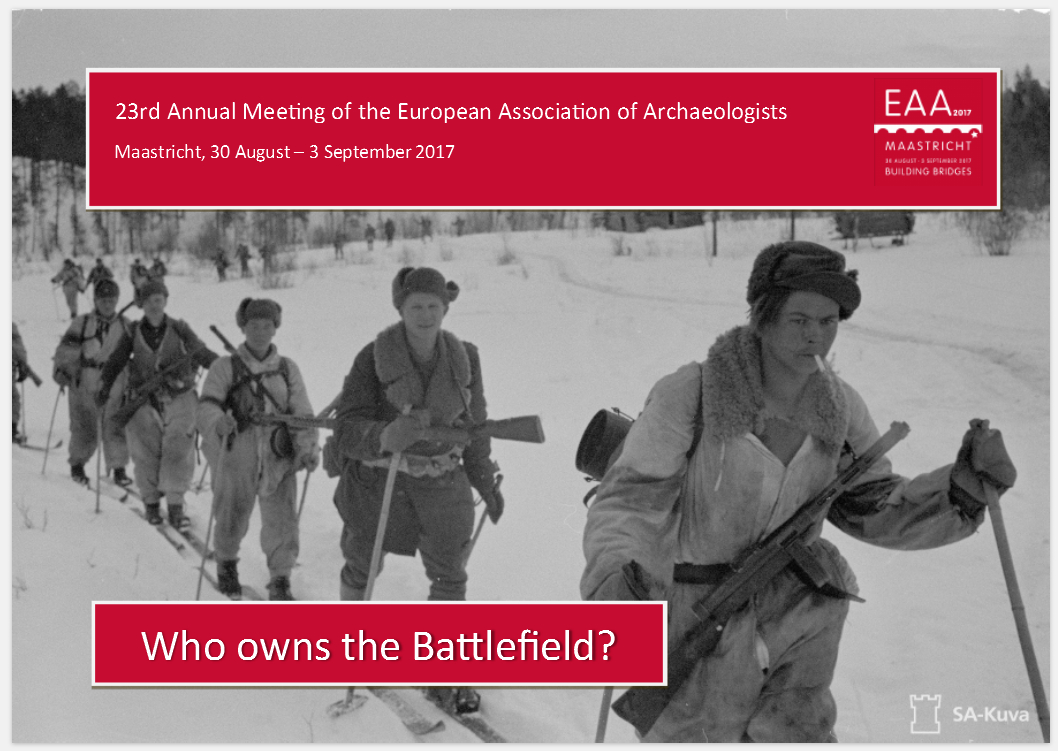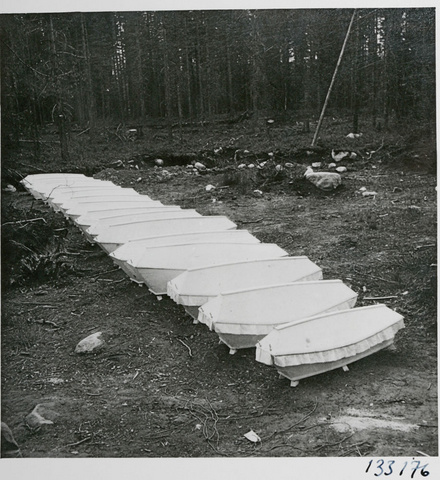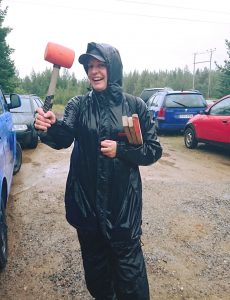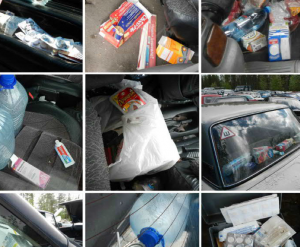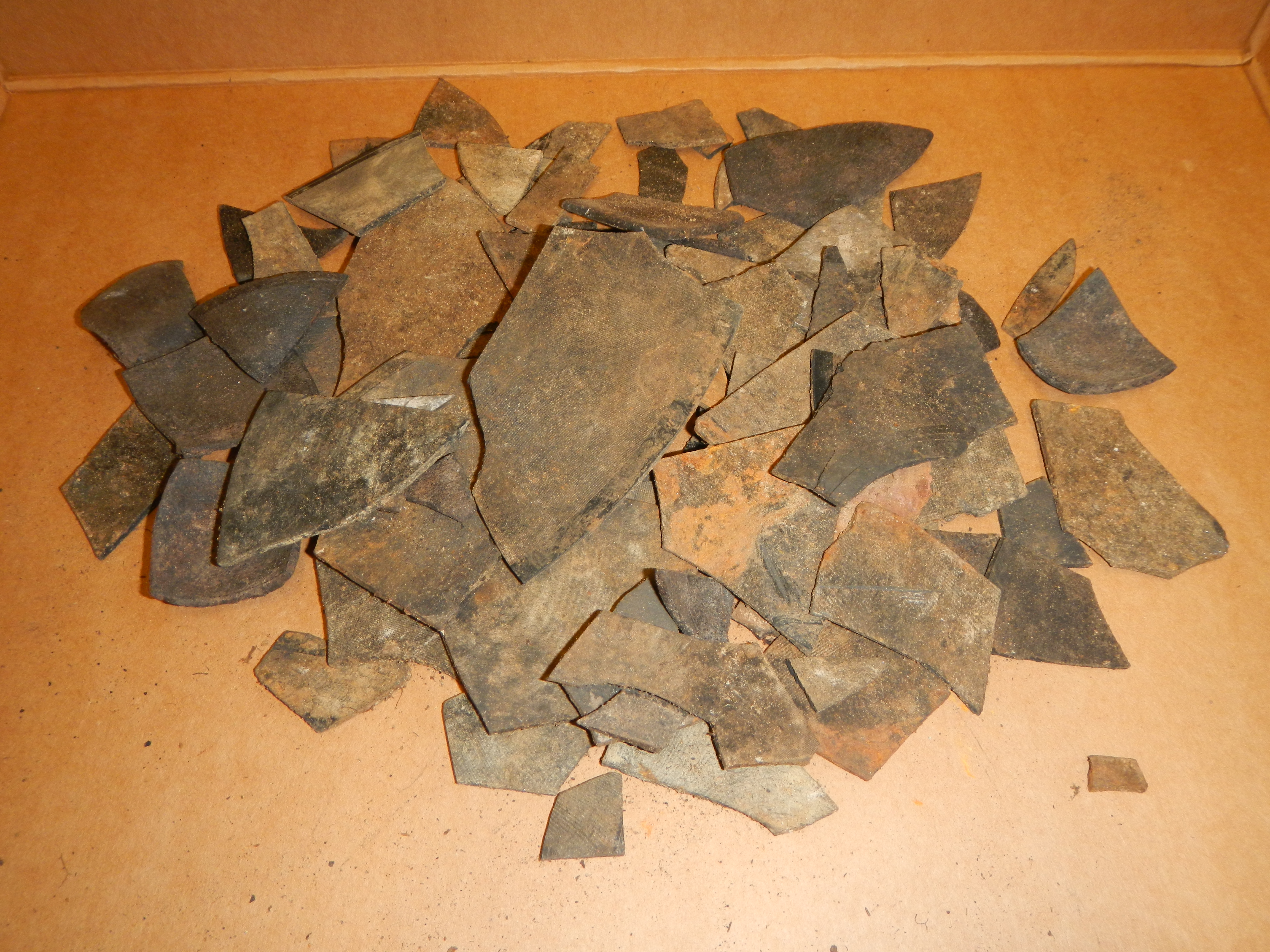
WW2-era gramophone record fragments (Photograph: Oula Seitsonen) / Toisen maailmansodan aikaisia gramofonilevyn sirpaleita (Valokuva: Oula Seitsonen).
Refitting, the art of putting scattered pieces recovered during the excavations back together, is a common method in archaeology. It is most often applied in the context of lithic and ceramic studies. However, in the aftermath of the #InariDig2, we have encountered a new kind of refitting puzzle, consisting of German WW2 gramophone record fragments.
Gramophone record fragments were dug from a trashpit at Inari Hyljelahti, the German military base and prisoner-of-war camp we studied this summer in our community and public excavations. Some of the fragments were burned and bent beyond recognition, but some of them are in a better condition. Based on the refitting, these appear to originate from at least three different records, probably smashed into the trashpit during the evacuation of the camp in Lapland War in autumn 1944.

Refitting record puzzle (Photograph: Oula Seitsonen) / Levypalapelin kasaamista (Valokuva: Oula Seitsonen).
So far we have managed to refit some sections of the records, and some of the fragments show relatively well preserved grooves. At least one of them has been manufactured by the Electrola company based on the fragmentary label, but none of the label fragments gives any hint of what has been on the records. Next question is, could there be anything recognizable left of the recordings on the discs, after lying over 70 years in small pieces underground, and how those sounds could possibly be extracted from the grooves? This could reveal us what the German soldiers and their Polish, Norwegian and other prisoners and forced labourers were listening at Hyljelahti during the war.
A handful of international research projects are developing approaches for reading old gramophone and vinyl records using digital methods, and there are some ideas of how this could be achieved with, for instance, a combination of laser scanning and various computer algorithms. We will explore these methods further over the winter.
Developing these kinds of methods is actually relevant also beyond the Hyljelahti fragments of (presumably) Nazi gramophone discs and whatever music or other recordings they might have contained. In many countries archaeologists engage already routinely in the study of sites from the early 20th century (not so often in Finland), and broken gramophone and vinyl records are one find category that archaeologists will be increasingly encountering during the excavations in future. Thus the development of computer-based “digital gramophone” methodology can be highly relevant thinking of the future of archaeology and the range of analyses the future archaeologists might need.

Archaeologist Wesa Perttola pondering upon the research possibilities of the record fragments (Photograph: Oula Seitsonen) / Arkeologi Wesa Perttola pohtii erilaisia levynpalasten tutkimusmahdollisuuksia (Valokuva: Oula Seitsonen).
Uudelleensovittaminen (refitting), eli sekalaisten arkeologisilla kaivauksilla löydettyjen palasten yhteenkokoaminen, on tavallinen arkeologinen tutkimusmenetelmä. Yleisimmin sitä hyödynnetään kiviesine- ja keramiikkatutkimuksissa. #InariDig2 -kaivauksemme jälkitöiden yhteydessä olemme kuitenkin törmänneet varsin toisenlaiseen uudelleensovituspalapeliin, joka koostuu saksalaisten toisen maailmansodan aikaisten gramofonilevyjen sirpaleista.
Gramofonilevyn kappaleet löytyivät viime kesänä roskakuopasta Inarin Hyljelahden saksalaisen sotilastukikohdan ja vankileirin yhteisö- ja yleisökaivauksilta. Osa palasista on palaneita ja taipuneita, mutta jotkin niistä ovat paremmassa kunnossa. Uudelleensovittamisen perusteella ne ovat peräisin ainakin kolmesta levystä, jotka on ilmeisesti paiskattu roskakuoppaan leirin evakuoinnin yhteydessä Lapin sodan aikana syksyllä 1944.
Tähän mennessä olemme onnistuneet sovittamaan joitakin osia levyistä ja joissakin palasissa myös urat ovat säilyneet suhteellisen hyvin. Ainakin yksi levyistä on repaleisen etiketin perusteella Electrola-yhtiön valmistama, mutta yhdessäkään etiketin palassa ei ole säilynyt vihjeitä siitä, mitä levyille on ollut nauhoitettuna. Seuraava kysymys onkin, olisiko mahdollista, että levynsirpaleissa olisi säilynyt jotain tunnistettavaa levytyksistä vielä 70 vuoden maakerroksissa makaamisen jälkeen, ja olisivatko nämä äänet mitenkään vielä tiristettävissä esiin levyjen urista? Jos tämä olisi mitenkään mahdollista, meille voisi paljastuisi mitä saksalaiset sotilaat ja heidän puolalaiset, norjalaiset ja muut vankinsa ja pakkotyöläisensä kuuntelivat Hyljelahdessa sodan aikana.
Muutama kansainvälinen tutkimusprojekti kehittelee tällä hetkellä digitaalisia menetelmiä, joilla olisi mahdollista lukea vanhoja gramofoni- ja vinyylilevyjä, ja on olemassa joitakin ideoita siitä, miten tämä olisi mahdollista esimerkiksi laserkeilausta ja erilaisia tietokonealgoritmeja yhdistelemällä. Tutkimme näitä menetelmiä ja niiden sovellusmahdollisuuksia tarkemmin talven kuluessa.
Tämänkaltaisten menetelmien kehittäminen on itse asiassa merkityksellistä myös laajemmin kuin vain Hyljelahden (oletettujen) natsigramofonilevynpalojen ja niiden sisältämän musiikin tai muiden levytysten osalta. Monissa maissa arkeologit tutkivat jo rutiininomaisesti myös 1900-luvun alkupuoliskolle ajoittuvia kohteita (Suomessa ei tosin kovin usein), ja rikkoutuneet gramofoni- ja vinyylilevyt ovat yksi löytökategoria, johon arkeologit törmäävät tulevaisuudessa tehtävillä kaivauksilla yhä useammin. Niinpä tietokonepohjaisten “digitaaligramofoni”-menetelmien kehittäminen voi olla hyvinkin oleellista, kun ajatellaan tulevaisuuden arkeologiaa ja tulevien arkeologien tarvitsemaa analyysikirjoa.



